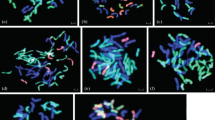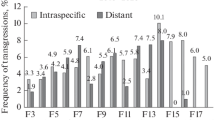Abstract
When breeding the primary spring octoploid triticale derived from crosses of various inbred rye lines to wheat Chinese Spring, the effects of the rye genotype and growth conditions on the plant height and proportion of the first, second, and final (pedicle) internodes to the entire stem length were studied. Two triticale groups were examined: homozygotes for the dominant (Ddw1) and recessive (ddw1) alleles of the gene responsible for short stem in rye. In the short stem triticale lines carrying the Ddw1 alleles, the plants were 20 cm shorter on average than those in the ddw1-carrying lines, and the distribution of the two triticale groups overlapped significantly. In both groups, the lines significantly differing in plant height could be differentiated, because of allelic diversity of the additional genes controlling this trait along with the Ddw gene. In most triticale lines, especially in theDdw1-carrying ones, the plant height was much reduced under unfavorable growth conditions. At the same time, a short-stem line was isolated, which is characterized by ecological plasticity, like the maternal wheat cultivar. In the triticale studied, the stem structure depended on the short-stem rye genotype. The two-year study showed that in the triticale carrying the dominant allele of this gene, the first internode is significantly extended, whereas the upper (pedicle) internode is reduced, which increases plant lodging resistance. The differences revealed between the rye lines as well as their effect on the quantitative triticale traits are discussed in view of a variant of the hybridological analysis, which had been previously proposed for identification and mapping of the correspondent rye genes.
Similar content being viewed by others
References
Baier, A. and Gustafson, J.P., Breeding Strategies for Triticale, Triticale: Today and Tomorrow: Developments in Plant Breeding, Guedes-Pinto, H., Darvey, N., and Carnide, V.P., Eds., the Netherlands: Kluwer Academic, 1996, pp. 563-570.
Mergoum, M., Pfeiffer, W., Rajaram, S., and Pena, R.J., Triticale at CIMMYT: Improvement and Adaptation, Proc. 4th Int. Triticale Symp., 1998, vol. 1, pp. 58-64.
Brady, I., Some Factors Influencing Lodging in Cereals, J. Argic. Sci., 1934, no. 24, pp. 209-232.
Gladysheva, N.M., Rostova, N.S., and Smirnov, V.G., Analysis of the System of Correlation between Morphological Traits and Lodging Resistance in Diploid and Tetraploid Forms of Winter Rye, Tsitol. Genet., 1977, vol. 11, no. 2, pp. 145-150.
Börner, A. and Plaschke, J., Dwarfing Genes of Wheat and Rye and Their Expression in Triticale, Triticale: Today and Tomorrow: Developments in Plant Breeding, Guedes-Pinto, H., Darvey, N., and Carnide, V.P., Eds., the Netherlands: Kluwer Academic, 1996, vol. 5, pp. 275-280.
Tarkowski, Cz., Gruschecka, D., Bichta, I., and Kowalczyk, K., Transfer of Genes Rht1, Rht2, and Rht3 from Wheat to Triticale, Triticale: Today and Tomorrow: Developments in Plant Breeding, Guedes-Pinto, H., Darvey, N., and Carnide, V.P., Eds., the Netherlands: Kluwer Academic, 1996, pp. 281-284.
Kraska, P. and Tarkowski, Cz., The Influence of Genes Rht1, Rht2, and Rht3 on Yield Components of Winter Triticale, Proc. 4th Int. Triticale Symp., 1998, vol. 2, pp. 24-26.
Wolski, T. and Gryka, J., Semidwarf Winter Triticale, Triticale: Today and Tomorrow: Developments in Plant Breeding, Guedes-Pinto, H., Darvey, N., and Carnide, V.P., Eds., the Netherlands: Kluwer Academic, 1996, vol. 5, pp. 581-588.
Shevchenko, V.Ch. and Goncharov, S.V., Introgression of the Dominant Short Stem Determinant into the Triticale Genome, Vestn. S.-kh. Nauki (Moscow), 1990, no. 10, pp. 29-33.
Sechnyak, L.K. and Sulima, Yu.G., Tritikale (Triticale), Moscow: Kolos, 1984.
Smirnov, V.G. and Sosnikhina, S.P., Genetika rzhi (Genetics of Rye), Leningrad, 1984.
Khotyleva, L.V., Turbin, N.V., Tarutina, L.A., et al., Tritikale: Sozdanie i perspektivy ispol'zovaniya (Triticale: Construction and Prospective Uses), Moscow: Nauka Tekhnika, 1986.
Oettler, G., Wehmann, F., and Utz, H.F., Influence of Wheat and Rye Parents on Agronomic Characters in Primary Hexaploid and Octoploid Triticale, Theor. Appl. Genet., 1991, vol. 81, pp. 401-405.
Jung, C. and Lelley, T., Genetic Interactions between Wheat and Rye Genomes in Triticale: 2. Morphological and Yield Characters, Theor. Appl. Genet., 1985, vol. 70, pp. 427-432.
Gordei, I.A., Tritikale: Geneticheskie osnovy sozdaniya (Triticale: Genetic Bases of Construction), Minsk: Navuka Tekhnika, 1992.
Voylokov, A.V. and Tikhenko, N.D., Identification and Localization of Rye Polymorphic Genes Specifically Expressed in Triticale, Proc. 4th Int. Triticale Symp., 1998, vol. 1, pp. 290-296.
Smirnov, V.G. and Karpechenko, G.D., Hundred Years of Studying Genome Reconstruction, Genetika (Moscow), 1999, vol. 35, no. 10, pp. 1326-1340.
Author information
Authors and Affiliations
Rights and permissions
About this article
Cite this article
Tikhnenko, N.D., Tsvetkova, N.V. & Voylokov, A.V. The Effect of Parental Genotypes of Rye Lines on the Development of Quantitative Traits in Primary Octoploid Triticale: Plant Height. Russian Journal of Genetics 39, 52–56 (2003). https://doi.org/10.1023/A:1022070810919
Issue Date:
DOI: https://doi.org/10.1023/A:1022070810919




